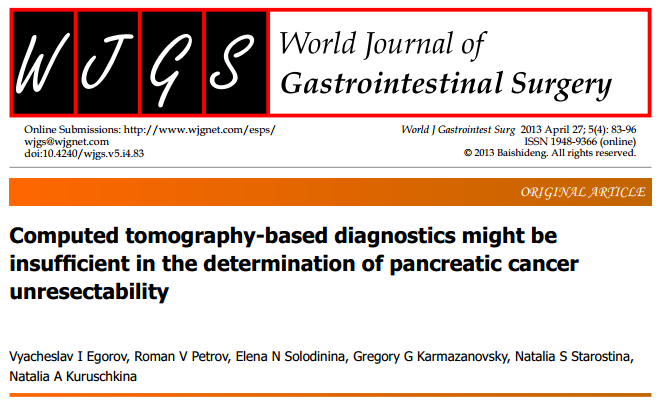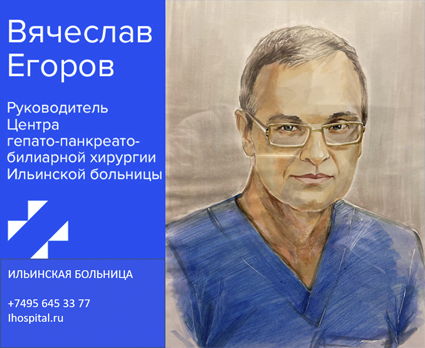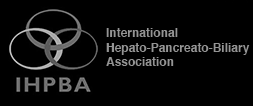Уважаемые коллеги,
Если вы познакомились со статьей «CT-based diagnostics of pancreatic cancer unresectability….», приведенной выше, большая просьба прислать ваши ответы на вопросы, заданные в этой статье в разделе Discussion и приведенные ниже, поскольку нас очень интересует ваше мнение.
Dear collegues,
This is Vyacheslav Egorov, Moscow, Russia. I need your comments on some subjects.
It is with great interest that I have familiarized myself with quite a few medical journal articles on confronting the accuracy of CT with that of other diagnostic modalities in the evaluation of arterial invasion in pancreatic cancer and I have stumbled across a number of questions with no suggested answers. I know some of you as an authoritative source of expert opinion on challenging pancreatology issues and I wonder if I could ask you to do me a favor and be so kind as to enlighten me on some most elusive points. In keeping with current guidelines, it is common practice to estimate pancreatic cancer resectability in the absence of distant metastases by involvement of peripancreatic arteries such as the celiac axis and superior mesenteric artery, and much more rarely the common hepatic artery, short segment abutment or encasement of which is not preclusive of pancreatic resection. In pertinent studies patients subjected to pancreatectomy, including those after a R1 resection, have been reported to survive significantly longer. That is to say, the radiologist’s interpretation dictates the patient’s being destined to either undergo resection or receive palliative surgery. In this context false-positive CT findings of arterial invasion become particularly salient. CT-predicted arterial tumor involvement not confirmed at operation is considered a false positive. In the setting of large pancreatic tumors the intrigue lies in that there are only two ways of proving or disproving arterial tumor invasion : either to excise the artery and examine the resected specimen or to skeletonize the artery circumferentially and see it be unaffected. Both are ill-advised in terms of present do’s and don’ts and the absolute preponderance of high-volume clinics adhere to these recommendations. Nevertheless , it is just these institutions that author publications (apparently owing to these centers’ large volumes of patients ) where one can come across reporting nonzero false-positive CT detections of arterial invasion and , correspondingly, a PPV ( positive predictive value ) of less than 100%.
In this connection I have a couple of questions to ask.
1. Do you obtain false-positive CT results of arterial invasion assessment in pancreatic cancer? If you do, what is/are the culprit/s? How can the surgeon appraise that intraoperatively? Would mere palpation suffice for him to determine that?
2. What makes the surgeon revise the arteries (primarily the CA and SMA, which is rather tedious) after CT has shown them to be involved.
3. How can the surgeon ascertain that the artery (especially the SMA and CA) is intact, if he/she does not resect it or does not perform extended pancreatectomies implying circumferential skeletonization of the CA and SMA? (This question is of much concern in view of the fact that it has been most clinics’ (including high-volume ones’) policy not to resort to extended pancreatic resections since they are deemed oncologically unwarranted.
4. What do you believe to be the main culprit/s for CT false-positivitieses? Talking this issue over with radiologists from different countries and institutions has not given me a clear insight whatsoever into this problem, which I find to be most relevant.
I would enormously appreciate your reply.
Yours faithfully,
Vyacheslav Egorov
Marco Del Chiaro, MD, PhD
Marco Del Chiaro
Dear Vyacheslav,
your email is really very interesting and, as you know, the topic is something I like very much.
Before to give you some answer that, unfortunately, I think will not be enough to solve the problems, I would like just to give some comments.
First, I think the problem we have, we miss a real definition of locally advanced pancreatic cancer. If you look in literature report, when people try to write some guidelines on this topic, they focus the attention on «resecability» (resectable, border line resectable, unresectable), but not on the extension of the disease. What I would like to underline is that mostly of the reports are more focused on a technical aspect that on an oncologic one. That’s an important bias. In particular if you consider the new classification of resection margin (Verbeke et al) where 80% of patient resected are positive (because the analysis also of anterior, posterior, etc surface), it’s quite clear that the vessels infiltration is only one part of the problem, oncologicaly.
Anyway, coming back to your questions:
1) Of course we have false positive. The problem, when you work with expert radiologists, is related to the real efficacy of CT to evaluate the margins. That’s particularly true for patient that received neo-adjuvanct treatment and for example radiotherapy where fibrosis or edema can mimicking a tumor invasion. Anyway, for these patients, I think there are no chances intra operativelly to do better. No way to discriminate manually fibrosis to cancer. Even a local biopsy is not useful. If is positive you risk to compromize the result of the operation touching tumor during the surgical procedure or, if not resectable, to promote short term carcinosis. If is negative, no way because can be positive in another point. A technique that can help in no clear cases, for example in the suspicion of invasion of SMA, can be to proceed with an artery first approach of the resection. In this case, after Kocher maneuver, before to do any irreversible step, you approach the right margin of the SMA from the back and you try to understand if there is or not infiltration there. It’s not a «scientific» perfect way, but is useful and can help.
2) A very «border line» result from CT scan as for example an irregularity of the retroperitoneal margin evaluated by the CT is, in my opinion, a reason to proceed for surgical exploration and artery first approach. In contrast a clear obliteration of this space is an indication to proceed for a neo-adjuvanct treatment and down-staging.
3) I think I gave you an answer in point 1. The way is to try to dissect the artery before to do any other irreversible step, but that should be done only in the CT unclear cases where the percentage of false positive is higher.
4) I think that the capability of CT to discriminate from fibrosis and cancer is always a problem. But in conclusion I can say, in my experience, that the problem is true only for small tumors with limited contacts. There is easy to have false positive and may be make a sense to do aggressive resections. They are not advanced, are only «unlucky» tumors. For the very big one, with multiple vessels involvement, CT is generally more accurate.
Anyway, as you mentioned, I think there are several problems and question marks on this topic. My idea (and if you want we can also try to drive this issue together) is that we need more clear idea in the issue because, even today, many patient not receive surgery and are not unresectable and in contrast, may be someone receive surgery and they are not resectable. Pancreas surgeons focalized for so long time the attention on technical problems (as vascular involvement) but loose the attention in what really locally advance PC means.
I think there is a big space to do an International survey on this issue to understand the state of the art all around the world and, after that, may be an EBM guidelines review (may be a consensus conference on it).
This is one project I have in my mind and, sometime, to do it alone, is difficult. So, if you think can be useful, we can think to do it together in the next future. What do you think about?
I hope I gave you some answer, but your questions are really open problems in pancreatology and is very difficult to give you an answer that is not just a «personal opinion»
I hope to see you soon
Sincerely
Marco
Marco Del Chiaro, MD, PhD
Ass. Professor of Surgery
Karolinska University Hospital
Department of Surgical Gastroenterology
SE-141 86 Stockholm, Sweden
Professor Grigory Karmazanovsky
The problem of over-diagnosis unresectability of pancreatic cancer is a real problem. If we say “no” to surgery in these patients, we will never know whether we were right or not, when did such a conclusion. However, any unjustified operation is unnecessary economic costs.
What I can say now, on the basis of a retrospective analysis of our results and reports on the European Congress – ESGAR?
I think that if there is no compression of the artery when it has a circular cross-section, there is a chance for resection of R1. Usually we evaluate the circumference involvement of the arteries. But it is necessary to evaluate the involvement along arterial axis also.
I think we should pay close attention to patients with arteries involvement less than 180 degrees and a length less than 2 cm.
Finally, we talk about “the invasion”, but there are individual angioarchitectonics. All exclusively depends on it.
If the patient has the replacement arteries, or will be provided collateral blood flow, it expands the concept of ”resectability”.
Professor Grigory Karmazanovsky
Chief of Radiology dep.,
Vishnevsky Institute of Surgery, Moscow
Saffire Phoa
Hello Dr Egorov,
thank you for your mail.
the main cause for false postive vascular invasion is presene of pancreatitis infiltration surroundingthe vessel.
in my our studies we always scored infiltratio as due to tumor, but we found mainly false positives for venous invasion.
we chose this option because probably one cannot between tumor or inflammation.
we wanted to prevent the issue of differentiation, because this may lead to the situation tat the surgeon will always operate a patient, because we cannot exclude there is only inflammation.
in our small series arterial involvement >180 degrees was always proven invasion at pathology.
however numbers were small. at the time of the study our surgeons we not always convinced of the outcome and operated on a few very young patients.
at present this criterion s accepted as invasion and patients are do not undergo resection.
also because we showed that when invasion was arterial invaion was present t Ct survival of patients would be ess than six months.
however there is a different approach in some hospitals, where surgeons will erfore an arterial resection when invasion is present.
also there is under investigation, performing arterial and or venous after neoadjuvant therapy.
even when ct shows vascuar invasion neoadj therapy is suggested to give a benefit
in Ro resections.
I would like to refer to our esgar poster of 2012.
Kind regards,
Saffire Phoa
(Professor. Phoa, an expert in radiology)
Prof. Masahiko Hirota
Drear Dr. Egorov,
Thank you very much for your E-mail.
Assessment of arterial invasion of pancreatic cancers is really troublesome as you mentioned.
Other than false-positive, we often experienced false-negative assessment on CT.
By the way, I am answering your diffisult questions on false-positive CT results.
1 Experience of false-positive CT results: No, I have not experienced any false-positive CT cases. However, the increase in CT density around the SMA and CA is often found in severe acute pancreatitis cases. If acute pancreatitis is induced due to obstruction of the pancreatic duct in pancreatic cancer cases, it would be very difficult to judge the increase in CT density around the SMA and/or CA is due to cancer infiltration or due to pancreatitis (fat inflammation). Hence, false-positive CT results can be occurred.
2. Resection of artery: A small pancreatic cancer at the tip of uncinate process which resides adjacent to the SMA is a good indication for SMA resection, although such a case is very rare. Otherwise, I don’t perform areterial resection.
3. Ascertainment of the artery involvement: We can ascertain the involvement from the findings around the SMA and/or CA on follow up CT. If the CT density around the SMA and/or CA is gradually increased afterwards, it would suggest the arterial involvement. On the other hand, if the CT density around the SMA and/or CA is not increased for a long time, it would suggest the uninvolvement.
4. Main culprit for CT false-positivity: Association of acute pancreatitis
The answers above are OK for you? If not, please let me know. I will re-think about it.
Sincerely yours,
Prof. Masahiko Hirota – the inventor of “no touch” technique in pancreatic surgery
Kumamoto Regional Medical Center
JAPAN
Nils Albiin, M.D., Ph.D.
Dear Dr. Egorov! Thanks for your interesting and important questions.
Right now we are performing a study to see how well we stage pancreatic cancer and its inter-reliability. Preliminary it looks fine. The most important criteria is how many degrees of the vessel circumference (axial plane) is involved by the tumor. We also measure the longitudinal length.
This means that if the tumor has no contact there is no problem to resect.
If we see contact, <50% of circumference (<180 degree) 1/3 will need vascular surgery.
If 50% or more, almost all will need vascular surgery.
In our study we can not correlate to histopathology concerning vascular infiltration (our pathology did not evaluate this).
The inter-reliability is excellent.
My answers to your question.
1. In those cases patients have been operated despite 50% or more this seem to correlate well with need of vascular surgery. Our surgeons first try to free the pancreas/tumor from the vessels by pulling and then by dissecting (mainly the patient with 1-49% involvement). Only palpation is, as far as I have understood, not sufficient in those cases. But in more clear cases palpation is enough.
2. In a young patient the surgeons want to give him/her a chance even though it looks too much. And some times they plan to do vascular surgery, especially on the veins. From this we have a lot of good experience. Our findings coincide with the surgery findings. One problem is if there is a delay (6 weeks or more) from examination to surgery.
3. Correct. From very extensive tumor cases we do not have much experience. But from less extensive we do have. The surgeons have tried now and then (young patient …) but they have not succeeded. But it happens that we have inflammatory infiltration but not due to tumor. It is uncommon but in these cases it may end up in not surgery on patient with potentially treatable tumor.
4. I think it is due to focal pancreatitis with edema infiltrating the vessel. I do not know how to find these patients. They exist, but they are so few so they are really tricky to find. For the individual patient it is horrible. Do you have an idea?
I hope I have correctly understood your questions.
Best regards
Nils
Nils Albiin, M.D., Ph.D.
Associate Professor
Division of Medical Imaging and Technology
Department of Clinical Science, Intervention and Technology (CLINTEC)
Karolinska Institutet/Karolinska University Hospital
SE-14186 STOCKHOLM, Sweden
Prof. Dr. Helmut Friess
Dear Friend
Thanks for your mail. You are raising a difficult area and you ask for answers where no clear answer can be gives. Such as surgery has limitation also radiology has limitations. To achieve 100% sensitivity, specificity or prevalence is just impossible.
Therefore the surgeon in combination with the radiologist have to see the pictures and with the explanations of the radiologist, the surgeon has to come to a conclusion/decision whether he goes for a resection or not.
Pancreatic cancer is a special disease with it own biological courses which are quite different from other cancers. Therefore infiltration along the arteries goes along the nerves and by doing extensive operations we cannot cure the patient. If the arteries or better said the periarterial tissue is involved the prognosis is limited and also by an extensive resection there might appear distant metastases soon after surgery.
In this connection I have a couple of questions to ask.
1. Do you obtain false-positive CT results of arterial invasion assessment in pancreatic cancer? If you do, what is/are the culprit/s? How can the surgeon appraise that intraoperatively? Would mere palpation suffice for him to determine that?
Yes, you as the surgeon has to decide
2. What makes the surgeon revise the arteries (primarily the CA and SMA, which is rather tedious) after CT has shown them to be involved?
I would go for a neoadjuvant therapy
3. How can the surgeon ascertain that the artery (especially the SMA and CA) is intact, if he/she does not resect it or does not perform extended pancreatectomies implying circumferential skeletonization of the CA and SMA? (This question is of much concern in view of the fact that it has been most clinics’ (including high-volume ones’) policy not to resort to extended pancreatic resections since they are deemed oncologically unwarranted.
There is no way to be sure
4. What do you believe to be the main culprit/s for CT false-positivity? Talking this issue over with radiologists from different countries and institutions has not given me a clear insight whatsoever into this problem, which I find to be most relevant.
Nobody can give you the right answer
Kind regards
H. Friess
Prof. Dr. Helmut Friess
Wolfgang Schima
Dear Dr. Egorov,
with your questions you directly pinpoint the most important problem in pancreatic tumor imaging. With modern CT and especially MRI (including diffusion-weighted imaging and hepato-biliary contrast agents) we have come a long way to detect liver metastases. We are still not very good in detecting small peritoneal implants, but fortunately these small implants are not that often present.
The real problem is the detection of arterial and venous invasion and the detection of perineural spreading or lymphangiosis along the uncinate process. We rarely encounter the problem of false-positive CT diagnoses of arterial invasion, meaning that we see arterial invasion with CT, when in fact it is not present during surgery.
What we encounter is false-negative CT diagnoses, meaning that we think that the tumor maybe resectable from CT or MRI findings, but in fact it is found to be unresectable during laparotomy.
Why is this more often the case? Simply because of the fact, that we give the patient the benefit of the doubt in case of equivocal CT findings.
In these cases where we are not sure the surgeons want to operate, knowing that doing no operation the prognosis is always fatal.
How can we deal with this problem of false-negative CT diagnoses, when in fact arterial invasion is found intraoperatively?
In my former hospital (the Medical University of Vienna) patients with tumors, which were deemed to be “borderline resectable”, neoadjuvant radiochemotherapy was applied and the patients were then subjected to laparotomy. The problem with this approach is that even in patients who are responders, CT after neoadjuvant therapy usually does not show shrinking of tumor. The tumor still sits at the vessels.
You will only find out after sharp dissection of the vessels, when histologic report tells you that there was just fibrosis present along the SMA or the celiac trunk and no vital tumor cells any more.
Some centres use FDG-PET/CT in this clinical setting, because if the FDG uptake decreases after neoadjuvant radiochemotherapy the patient is most likely a histologic responder.
However results of recent studies are not very convincing, that this approach is really helpful.
In my new hospital, where we don’t do neoadjuvant radiochemotherapy the surgeons would go in and try to dissect. We do not routinely perform intraoperative ultrasound, as this is probably not better than endoscopic ultrasound in this particular setting. If they find during palpation that they think there is arterial infiltration, then they would abort the procedure.
However, in most cases they would try to dissect the vessel, with the risk that histologic inspection of the resection specimen at the vessel shows that there are tumor cells at the edge of the surgical specimen.
Unfortunately, there is no 100%-accurate imaging method, not even dual-source or 320 row multidetector-CT.
What did help me a lot as a pancreas radiologist, was to get feedback from my surgeons after the operation and then to sit over the images a second time knowing the surgical (and histopathological) results.
This is the only way to improve the learning curve as a radiologist in this matter.
So I hope that you already have (or will find) a radiological colleague you can discuss all your cases with!
Yours sincerely
Wolfgang Schima
Brugge, William R.,M.D.
Dr. Egorov-
These are interesting comments and observations. In general, it is difficult to have objective findings of unresectability at the time of surgery. Therefore, it is difficult to determine with great accuracy, the CT findings of arterial invasion.
I will ask my surgical colleague at MGH, Carlos Fernandez, to respond to your questions.
Bill
Brugge, William R.,M.D.
Colin Johnson, Professor of Surgery
Dear Dr Egorov
Thank you for your carefully written letter. Your questions are most pertinent. I have added my replies below
Colin Johnson
1. Do you obtain false-positive CT results of arterial invasion assessment in pancreatic cancer? If you do, what is/are the culprit/s? How can the surgeon appraise that intraoperatively? Would mere palpation suffice for him to determine that?
We rely on CT for assessment, so if the scan shows arterial involvement we would not operate. The only exception would be if we suspect acute pancreatitis in addition to tumour, then we would mobilise as much as possible, and send frozen section of the margin before we make a decision about resection
2. What makes the surgeon revise the arteries (primarily the CA and SMA, which is rather tedious) after CT has shown them to be involved?
I do not understand this question
3. How can the surgeon ascertain that the artery (especially the SMA and CA) is intact, if he/she does not resect it or does not perform extended pancreatectomies implying circumferential skeletonization of the CA and SMA? (This question is of much concern in view of the fact that it has been most clinics’ (including high-volume ones’) policy not to resort to extended pancreatic resections since they are deemed oncologically unwarranted.
The surgeon cannot make this judgement
4. What do you believe to be the main culprit/s for CT false-positivity? Talking this issue over with radiologists from different countries and institutions has not given me a clear insight whatsoever into this problem, which I find to be most relevant.
Acute pancreatitis with peripancreatic inflammatory thickening odf the tissues
Colin Johnson,
Professor of Surgery
Nicolas C. BUCHS, MD
Dear Professor Egorov,
Thank you for the nice comment and feedback.
To reply to your questions/comments:
1. Arterial involvement remains really a difficult preoperative diagnosis, except in very clear cases. That’s the reason why a surgical exploration should not be denied to those suspected patients. Palpation is a good clinical mean to assess the risk of involvement, but yet often only after a careful dissection the diagnosis is clear… we should emphasized the role of local inflammation that can render the diagnosis of invasion difficult. It was clearly demonstrated that this inflammation can mimic tumoral invasion…
2. You are right and it remains debatable if we should offer an exploration to all patients or not. Several groups propose arterial resection in the cases where an invasion is encountered during the operation. In our institution, we do not perform arterial resection. Yet, with good preoperative angioCT, coupled for example with EUS, the risk of arterial invasion is usually well assessed, even if it is not 100%. In case of doubt, an exploration is recommended.
Sincerely yours.
Nicolas C. BUCHS, MD
Head of the Multidisciplinary Center for Surgical Teaching — Centre Multidisciplinaire d’Enseignement Chirurgical (CMEC)
Department of Surgery
University Hospital of Geneva
Switzerland
The mistake usually comes from the inflammation around the tumor that does not imply a tumoral invasion as it was heavily reported in the literature (see pubmed).
Again, the sensitivity and specificity of CT is not 100%, and this is the reason why usually a multimodal imaging modality is routinely performed to assess this parameter. The biopsy will of course not be taken on the arterial wall but on the surrounding tissue if there is a doubt. Yet, even if the CT can show a suspicion of arterial invasion, it does not imply that there is no dissection plan.
Concerning the other questions I can give only the same answers. Today, there is no perfect imaging modality. Progress is done every day but we live in a imperfect world. We need to evaluate this situation case by case, if possible after a careful workout including EUS, CT, biopsy for example. Yet, there will be still patients with possible resectable cancer who are not operated on and patients with unresectable cancer that are explored. From my point of view, it is better to explore patients in case of doubt because it is the only way to cure them.
BR
Nicolas































